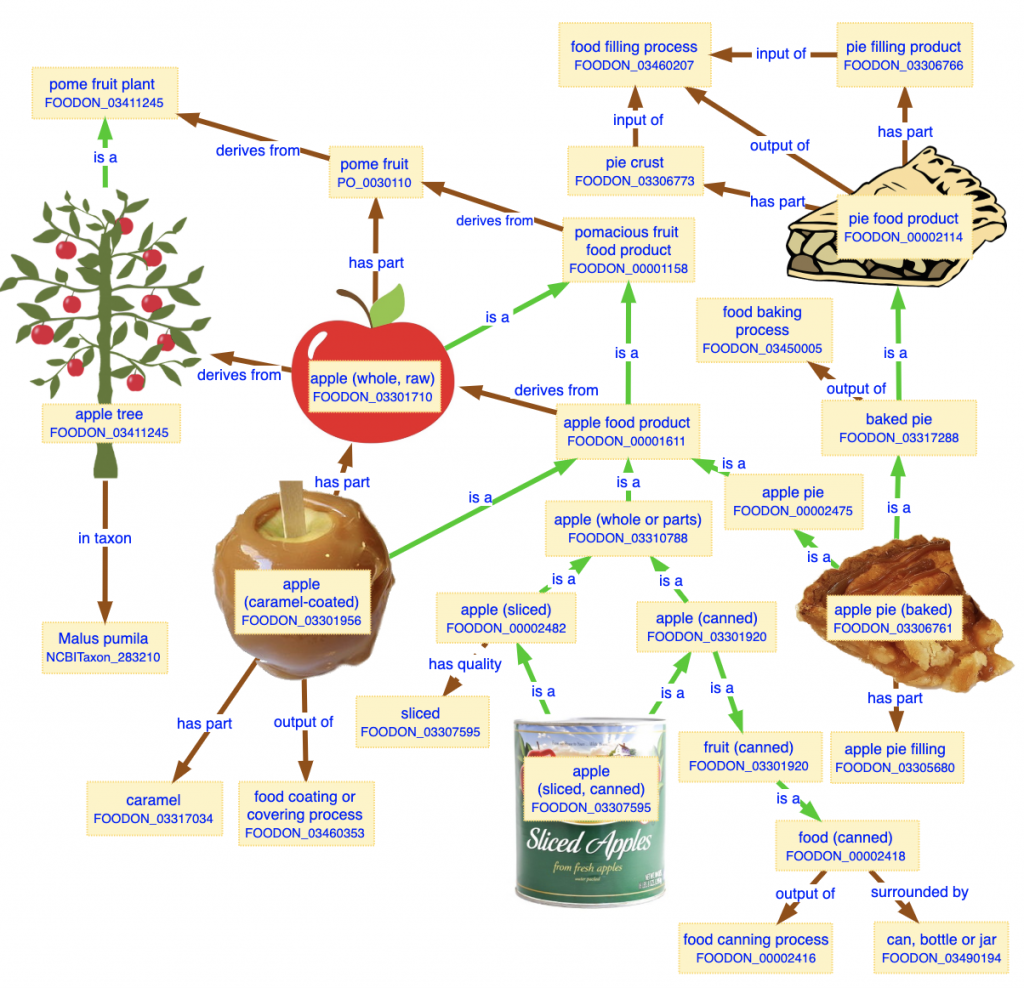This diagram explores the apple tree food source to food product relationships: three different kinds of apple-related products are shown in relation to a food source organism (apple tree) and various food preparation and packaging processes.

FoodOn uses the following object properties.
| Object property | Use |
| has part | Used between entities of the same type, e.g. between anatomical entities, (e.g. “albumen” is part of an egg) or between proscriptive parts (e.g. “a pie has a crust and a filling”). A “part” often plays a functional role with respect to the whole. |
| has quality | Used to connect a food product to a quality it has, like colour, or texture. |
| has substance added | An object property which can apply to any substance roles – chemical, physical, food, etc. It differs from “has part” because the added substance may not be discernible at a later time in the mixture or thing it was added to. |
| has ingredient | A sub-property of “has substance added” pertaining just to a food domain and range. It is used to refer to a food substance added to a food product. If an ingredient is visually recognizable in a food it can also be a mereological part of the food, as in the apple and caramel parts of a caramel apple. Currently “has ingredient” is defined in FoodOn, not in the Relation Ontology. |
| has defining ingredient | A sub-property of “has ingredient” used to convey that a food product wouldn’t be given the label it has unless the indicated ingredient is included in it. |
| member of | Use to associate a food product with a product type category that is outside of the FoodOn “food product” branch (e.g. EFSA or GS1). By avoiding “is a” subclass-class axioms between FoodOn food products and agency food categorization hierarchies, we insulate to some degree FoodOn product type logic from any inconsistencies that arise from agency conjunctions or disjunctions of categories. |
| X ‘derives from’ Y | Essentially process shorthand for a more elaborate process model. Note that the relation ontology “derives from” object property currently states that the entity Y ceases to exist as a result of the formation of X; in some cases this might be problematic if a product X uses only some component of Y. |
| has food substance analog | Allows two products to be linked when they have similar phenotypic properties or process roles. |
FoodOn, like many other OWL ontologies, allows some relations to implicitly be true for some time or duration, but not for all time, for simplicity’s sake. An apple can have (‘has quality’) some ripe quality at some time t, but not at all times. Meanwhile it can derive from some ‘Malus domestica’, something one can say is true at all times.
The following relations have been phased out:
- X ‘develops from part of’ Y and X ‘produced by’ Y: We now leave it to external ontologies like the Plant Ontology to axiomatize developmental relations between organisms and their parts (e.g. pome fruit development). (X “produced by” Y was previously used to describe the production of a substance that does not undergo biological growth, like milk, which may be available in a quantity that can be harvested for food.)
- X ‘has taxonomic identifier’ Y: has been replaced by RO “in taxon”.
- X ‘in taxon’ Y (previously “has taxonomic identifier”): X is an organism in the clade given by NCBITaxon Y. This is being phased out in favour of a simpler “[organism part] and ‘derives from’ some [NCBITaxon or FoodOn organism reference]” pattern.